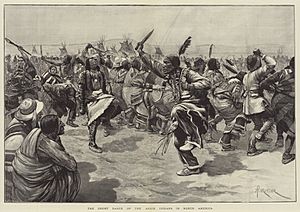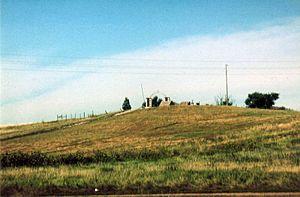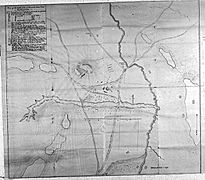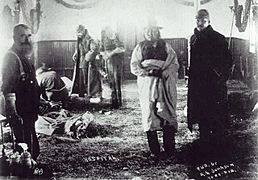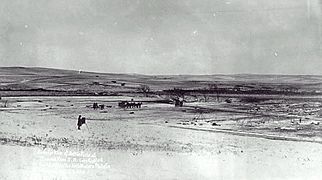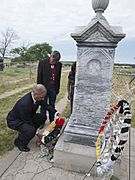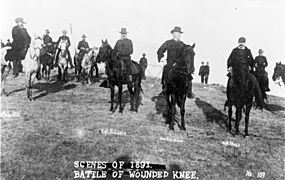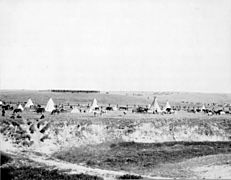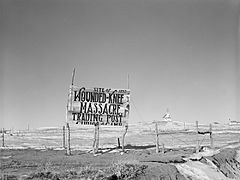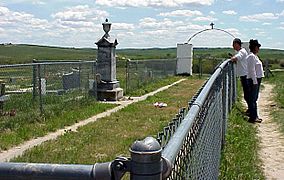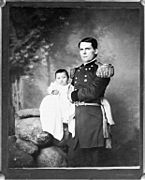Wounded Knee Massacre facts for kids
Quick facts for kids Wounded Knee Massacre |
|||||||
|---|---|---|---|---|---|---|---|
| Part of the Ghost Dance War and the Sioux Wars | |||||||
|
|||||||
| Belligerents | |||||||
| Miniconjou Lakota Hunkpapa Lakota |
|||||||
| Commanders and leaders | |||||||
| Spotted Elk † | |||||||
| Strength | |||||||
| 490 | 120 | ||||||
| Casualties and losses | |||||||
| 31 killed 33 wounded |
90 killed 4 wounded |
||||||
| 200 Native American women and children killed 46 Native American women and children wounded |
|||||||
The Wounded Knee Massacre, also known as the Battle of Wounded Knee, was a terrible event where many Lakota people were killed by soldiers from the United States Army. It happened on December 29, 1890, near Wounded Knee Creek in South Dakota. This area is part of the Lakota Pine Ridge Indian Reservation.
The massacre happened after U.S. soldiers tried to move the Lakota to a camp and take away their weapons. By the end of the day, more than 250 Lakota men, women, and children had died. Another 51 were hurt, and some of them died later.
Contents
Why Did the Wounded Knee Massacre Happen?
For many years before this event, the U.S. government kept taking land from the Lakota people. They broke promises made in treaties. The government often called Native Americans "hostile" when they were upset about losing their land.
The traditional way of life for the Lakota was being destroyed. European settlers were taking their land and making bison (buffalo) almost extinct. This meant the Lakota could no longer live as nomadic people who followed the buffalo for food and clothing.
The Ghost Dance and New Hope
During this difficult time, a new religion spread among Native American reservations. It was started by a Paiute prophet named Wovoka. He taught about the Ghost Dance. Wovoka believed that if people performed a special slow dance and wore unique shirts called Ghost shirts, peace would return.
Many Great Basin tribes and Plains tribes found hope in the Ghost Dance. They believed it would make the white settlers disappear and bring the buffalo herds back. They also hoped to be reunited with loved ones who had died and return to their old way of life.
Fear and Arrests
The Ghost Dance worried many U.S. settlers. They thought it would lead to violence. The U.S. government decided to stop the dance. They sent soldiers to arrest some Native American chiefs.
One arrest, that of Sitting Bull at Standing Rock, went wrong. He was killed along with some of his people. After Sitting Bull's death, about 200 members of his Hunkpapa group became scared. They left Standing Rock to find Chief Spotted Elk (also known as "Big Foot").
Spotted Elk and his Miniconjou group, along with 38 Hunkpapa, left the Cheyenne River Indian Reservation. They were traveling to the Pine Ridge Indian Reservation to find safety with Red Cloud. However, the army stopped them and brought them to a camp at Wounded Knee Creek. The rest of the 7th Cavalry Regiment, led by Colonel James W. Forsyth, arrived and surrounded the Lakota camp. The soldiers had four large guns called Hotchkiss mountain guns pointed at the camp.
The Wounded Knee Massacre Begins
On the morning of December 29, U.S. Cavalry troops entered the camp. Their goal was to take away the Lakota's weapons. No one knows for sure who fired the first shot.
During the process of collecting weapons, a deaf man named Black Coyote did not want to give up his rifle. He said he had paid a lot for it. At the same same time, an old man began performing a Ghost Dance ritual. It is believed that Black Coyote's rifle accidentally fired at this moment.
The U.S. Army then began shooting at the Lakota. Some Lakota grabbed rifles from piles of weapons and fired back at the soldiers. This close-range fighting lasted only a few minutes, as many Lakota were unarmed. While this was happening, other soldiers surrounding the camp fired the Hotchkiss guns into the camp. This area was full of women and children.
Escape and Pursuit
The Lakota women and children tried to escape the camp. They ran to find shelter in a nearby ravine (a deep, narrow valley). Some soldiers killed the wounded people. Others got on their horses and chased the fleeing Native Americans. They chased men, women, and children for miles across the open land, killing many more.
What Happened After the Massacre?
After the massacre, a three-day blizzard (a severe snowstorm) hit the area. The military then hired civilians to bury the dead Lakota. The burial party found the bodies frozen. They gathered them and placed them in a large mass grave on a hill. This was the same hill where the army had used its Hotchkiss guns. Reports said that four babies were found alive, still wrapped in their dead mothers' shawls.
Colonel Forsyth, who led the soldiers, was not punished for the massacre. In fact, twenty soldiers were given the Congressional Medal of Honor. In June 2019, some members of the U.S. House of Representatives tried to pass a bill called the Remove the Stain Act. This bill would cancel those awards. As of 2023, it has not been passed.
Remembering Wounded Knee
Honoring Native American Victims
In 1891, a Ghost Shirt believed to have been worn by someone who died in the massacre was taken to Glasgow, Scotland. It was shown in the Kelvingrove Museum until 1998.
In 1903, the families of those who died built a monument at the grave site. Part of the monument reads: "This monument is erected by surviving relatives and other Ogalala and Cheyenne River Sioux Indians in memory of the Chief Big Foot massacre December 29, 1890. Many innocent women and children who knew no wrong died here."
The Wounded Knee Battlefield was recognized as a U.S. National Historic Landmark in 1965. It was also listed on the U.S. National Register of Historic Places in 1966.
Since 1986, a group called "Big Foot Memorial Riders" has honored the victims. Riders on horses retrace the path their family members took to Wounded Knee. They carry a white flag to show their hope for world peace and to remember those who died.
Remembering the Seventh Cavalry Regiment
On July 25, 1893, a monument was put up for the soldiers of the regiment who died at Wounded Knee. This stone monument still stands today near Waters Hall at Fort Riley.
Wounded Knee in Books and Movies
Battle or Massacre: What's the Right Word?
At first, the event was called the "Battle of Wounded Knee." However, many Native American groups call it the "Wounded Knee Massacre." The place where it happened is officially known as the "Wounded Knee Battlefield." The U.S. Army now refers to it simply as "Wounded Knee."
Wounded Knee in Media
Historian Dee Brown wrote a famous book called Bury My Heart at Wounded Knee. It tells the story of Native Americans in the American West in the late 1800s. Other books, including comic books, have also been written about the massacre.
Many songs have been written about Wounded Knee by both Native American artists and others. Movies and video games that include characters or stories from the Wounded Knee Massacre have also been made.
Interesting Facts about the Wounded Knee Massacre
- The Lakota were part of a larger group of tribes called the Sioux.
- Many Lakota prefer not to be called "Sioux" because it was a name given to them by their enemies.
- Chief Sitting Bull was a very important leader in the Battle of Little Bighorn.
- Chief Spotted Elk was also known as Chief Big Foot.
- Since Wounded Knee, Native American activists have worked hard to show the world that the U.S. government took away their civil rights.
Gallery
-
US Attorney General Eric Holder laying a wreath at the site of the Wounded Knee Memorial
See also
 In Spanish: Masacre de Wounded Knee para niños
In Spanish: Masacre de Wounded Knee para niños


